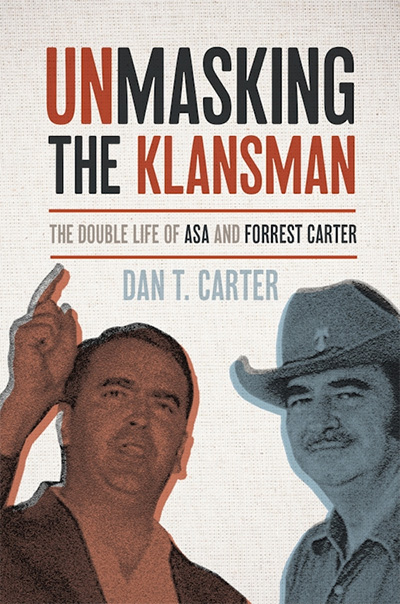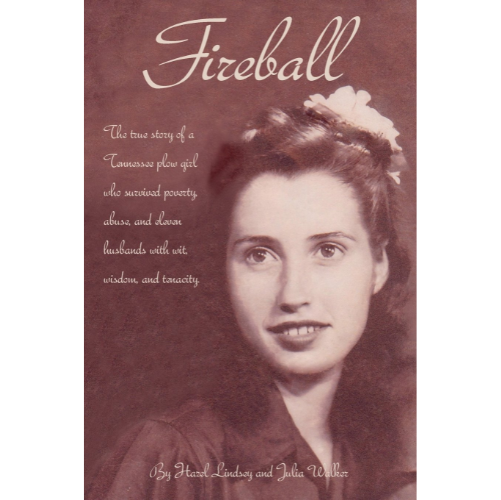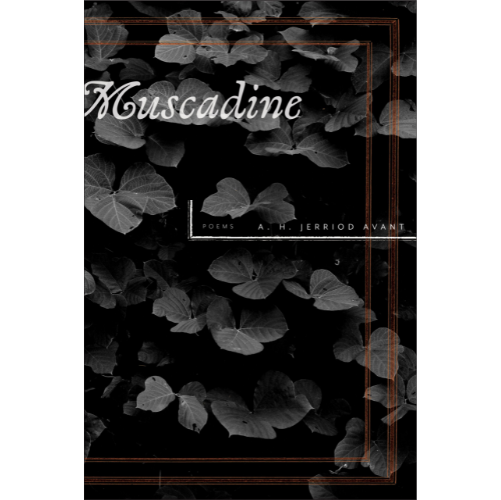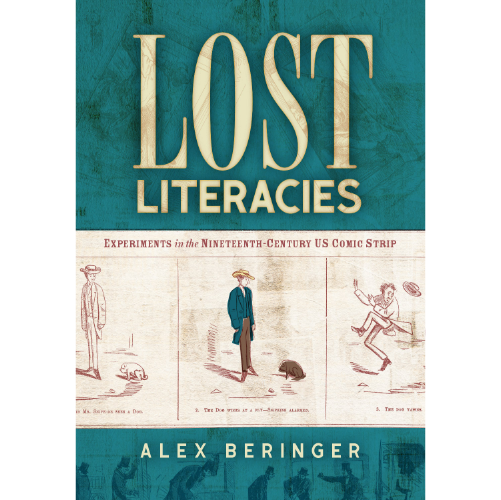By Dan Carter
University of Georgia Press, NewSouth Books Imprint; 2023
Hardcover: $19.98
Genre: History
Reviewed by Edward Journey

Those who care to know are probably aware of the bizarre story of Asa Carter, the hate-mongering antisemitic Klansman and speech writer for George C. Wallace. After financial and reputational ruin, Asa Carter disappeared from public view for a time, “decided to become an Indian,” and reemerged as “Forrest Carter,” a Native American who wrote the novel that became Clint Eastwood’s popular film, The Outlaw Josey Wales. “Forrest Carter” also wrote the completely fictional “autobiography,” The Education of Little Tree. Despite the ruse, which was eventually exposed in The New York Times and other outlets, The Education of Little Tree is still read by American school children. This might be a funny story if some of the details were not so horrible.
Author and historian Dan T. Carter (no relation to Asa) writes, “Myths, by their nature, are often more appealing than facts.” Dan Carter is one of those who exposed Asa Carter’s deception. He wrote the Wallace biography, The Politics of Rage, in 1995, and that research probably makes him uniquely equipped to write Unmasking the Klansman: The Double Life of Asa and Forrest Carter, a well-documented biography of the man who penned some of Wallace’s most divisive speeches.
Much of the book traces the factors that formed Asa Carter’s extreme political beliefs and his obsession with a “Jewish-Communist conspiracy.” As a child in Calhoun County, Alabama, Carter played with Black children and his high school classmates could not “remember Carter expressing strong opinions on any subject except sports.” A life-long problem with alcohol abuse and a stint in the U.S. Navy in World War II, where he joined reading groups that focused on fascist-charged ideologies, seem to have triggered Carter’s extremism. After the war, he attended the University of Colorado, became active in right-wing extremism, and found employment as a broadcaster at a right-wing religious Denver radio station.
After a job as a radio commentator in Yazoo City, Mississippi, Carter and his family moved to Birmingham, where he began broadcasting “Liberty Essays” for a local radio station. He became a propagandist for the American States Rights Association (ASRA), founded to fight for the “death of Communism and the protection of our race.” He organized for Alabama Citizen’s Councils, which one Birmingham reporter called “Klansmen in business suits,” published a magazine, The Southerner, and was secretly a member of the Ku Klux Klan. “The fight against communism” became a useful political code for organizations trying to discredit liberals as communists, but Carter had little use for code in his racist vendettas. “We don’t want peace in our time, we want the trouble now,” he announced at a Birmingham rally.
Carter organized the “Original Ku Klux Klan of the Confederacy,” requiring a blood oath at initiation. He ran for Birmingham’s Commissioner of Public Safety against the notorious Eugene “Bull” Connor and managed to make Connor “appear slightly less extreme.” While Carter’s associates were implicated in some of the most infamous attacks of the Civil Rights era, Carter himself managed to run away or direct from a distance so that he could deny his participation. One Birmingham police officer stated, “When bad things happened, he always seemed to find a way to stay out of the line of fire.”
Carter was linked to so many criminal activities that he eventually became a “pariah in Alabama politics.” Despite this, George Wallace hired Carter as a speechwriter for his 1962 gubernatorial campaign. In 1963, Wallace declared “Segregation Now … Segregation Tomorrow … Segregation Forever!” at his first inauguration as Alabama’s governor and the state has been plagued by those words ever since. Asa Carter wrote that fiery speech while drunk in a Montgomery hotel room. When Wallace became governor, he installed Carter in a room in the Capitol basement and continued to use him as a speechwriter through two presidential campaigns. Ultimately, Wallace broke ties with Carter and Carter ran against his former boss in the 1970 governor’s race.
Asa Carter always embellished his family history, but the next chapter of his life represents stunning mendacity. With his family’s knowledge and cooperation, Asa reinvented himself as a Texan and Native American novelist – Forrest Carter. Carter announced that “I want to be a Hemingway.”
“Forrest” Carter seems to have had a knack for impressing sophisticated, well-placed women in publishing and media. People who knew “Forrest” commented on his “folksy innocence.” The first woman editor at the William Morris Agency saw potential in Carter’s first novel, Gone to Texas. His agent negotiated publication and a movie sale and Clint Eastwood’s film adaptation, retitled The Outlaw Josey Wales, was a success.
Forrest Carter’s “autobiography,” The Education of Little Tree, was a total fabrication about a boy and his Cherokee childhood raised by grandparents in the mountains of Tennessee. Actual Cherokee readers were keenly aware of incongruities within the text; the New York Times published a short article by an Alabama reporter questioning Forrest Carter’s identity as early as 1976. These red flags were mostly ignored or denied.
Even in death, in 1979, Carter was as cagey as he had been in life. He was buried and eulogized as Forrest Carter, with one eulogist commenting that his friend, Forrest, “never spoke negatively about anyone.” One of Asa’s sons claimed that Asa had died years earlier and that Forrest was a “cousin” who had married Asa’s wife and been like a father to his children.
Years after his death, Eleanor Friede, Carter’s former agent, oversaw the reissue of The Education of Little Tree and it became an award-winning bestseller. It remains popular, even now that the duplicity of its author is common knowledge.
As fascinating and unlikely as the life story of Asa Carter may be, its true value to the contemporary reader may be its examination of the political education and radicalization of Asa Carter and its application to current events. In an epilogue called “Reflections,” Dan Carter juxtaposes a 1959 commentary about immigration by Asa Carter with a 2021 Fox News commentary by Tucker Carlson. The similarities are stunning.
Dan Carter’s wife warned him about tackling this book: “Do you really want to spend years getting inside the skin of Asa Carter?” she asked. In certain disturbing passages of the book I found myself thinking Do you really want to read this? Now that I have read it, my answer is yes. It provides illumination to a historical past that I have long been interested in and it provides insight into the times in which we live and the threats that surround us – from covert back-alley meeting places to state houses.
Edward Journey, a retired educator and theatre professional living in Birmingham, regularly shares his essays in the online journal “Professional Southerner” (www.professionalsoutherner.com).





